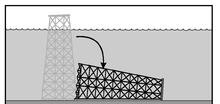There comes a time when the useful life of an oil platform comes to an end - at least when it comes to drilling for oil.
Rigs-to-Reefs?
Rigs-to-Reefs (R2R) provides an alternative to complete rig removal in which an oil company chooses to modify a platform so that it can continue to support marine life as an artificial reef. Through this decommissioning process, the oil well is capped and the structure is either towed, toppled in place, or the upper 80 ft are removed and the remaining structure is left in place. Not all platforms are suitable as reefing candidates, and in order for any platform to be considered for reefing, it must first undergo extensive ecological evaluations to assess any potential value it might add to the local ecosystem.
“BSEE continues to support and encourage the reuse of decommissioned platform jackets as artificial reef material”
Oil rigs as an artificial reef, really?
Scientific studies have concluded that the underwater platform structures has the potential to support ecologically valuable ecosystems. The complete removal of these oil and gas platforms will unquestionably harm the animals and plants that call these structures home.
“...the oil and gas platforms off California are among the most productive habitats globally.”
Costs of Rigs-to-Reefs?
R2R yields an economic benefit to both state and oil company stakeholders. The cost of implementing the R2R program is significantly less than the alternative of complete removal; resulting in potential cost savings in the millions.
What about liability?
Through the R2R process, the oil well is capped and the platform structure is modified at the expense of the oil company, so that is can continue to support marine life. The oil company then donates the underwater platform to the state to manage as an artificial reef, while retaining financial liability for the oil well should there be leakage.


